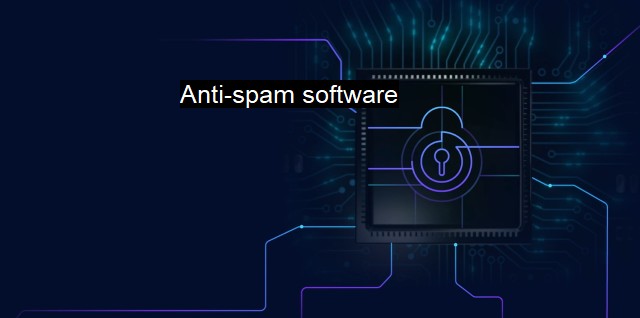What is Anti-spam software?
The Importance of Anti-spam Software in Cybersecurity: Protecting Individuals and Organizations from Unwanted and Dangerous Email Messages
The concept of anti-spam software emerges as one of the most essential defense tools in the cyberspace. Anti-spam software, fundamentally, is a program built to detect, prevent, and remove spam emails, instantaneous messages, or other forms of cyber communications from clogging a user's system. In a world increasingly dependent on digital communication, the demand and necessity for such software has surged extensively.While unsolicited communications may typically be irritating and bothersome they constitute a much more severe threat. Spam usually serves as a medium for phishing scams, malware, ransomware attacks, and other harmful cyberattacks which can lead to the loss or theft of sensitive information including credit card numbers, personal identification information, and confidential business data. This is precisely where the role of anti-spam software steps into the frame, demarcating itself as a frontline offensive and defensive bolster against such instigating threat.
Anti-spam software uses a myriad filtering techniques to smoothen out the influx of communications. Tagged spam messages are either automatically rerouted to a separate folder or blocked entirely. Some techniques that anti-spam software might use for filtering include; signature-based detection, which compares incoming content with known spam signatures; Bayesian filtering, which applies statistical methods to determine if an incoming message is spam; heuristic analysis, which builds a profile of and checks new messages against known spam attributes; and challenge-response systems, where emails from unknown senders prompt a challenge to verify the sender's validity.
Arguably, the connective features of global cyberspace have spiked opportunities for spam attacks. Actions as simple as clicking on suspicious links or downloading an unusual file can trigger disastrous cyberattacks. Here, antivirus software plays its part, cohabiting and often co-functioning with anti-spam software. These software solutions are designed to not only scan, but detect and bar potential threats or already-placed malicious code such as viruses, trojans, and worms in a computer system or network.
Anti-spam software and antivirus software establish a symbiotic relationship concerning cybersecurity. While anti-spam software streamlines communication inflow, blocking potential threat-carrying spam, antivirus prevents these threats from assailing the system if the spam somehow bypasses the barricades. It also ensures to clean the system later if the spam gets through.
Key characteristics that anti-spam and antivirus software companies aim to develop include real-time detection and prevention, frequent updating of spam and virus signature databases, swift processing, user-friendly interfaces, and minimal usage of system resources. Their importance magnifies considerably due to their capability to combat advanced and threatening forms of cybercrimes seamlessly that are becoming increasingly sophisticated.
Anti-spam software acts as the critical first line of defense against potentially damaging digital threats. Together with antivirus software, they form a robust protective shield against cyber-attacks - closing loopholes, fortifying network security, and ensuring the integrity and confidentiality of data in our hyperconnected cyberspace. Balancing cyber protection to ensure smooth operations, these software tools are pivotal in the current digital age, helping individuals, businesses, and organizations manage the potential risks of an ever-evolving digital landscape.

Anti-spam software FAQs
What is anti-spam software and how does it work?
Anti-spam software is a type of cybersecurity tool that is designed to identify and block unwanted and unsolicited emails or messages that contain spam, phishing, or malware. It typically uses a combination of filtering techniques, such as signature-based detection, heuristic analysis, and machine learning algorithms to assess and quarantine suspicious messages before they reach the inbox.What are the benefits of using anti-spam software?
The main benefits of using anti-spam software are that it helps to reduce the risk of cyberattacks and data breaches that can result from clicking on malicious links, downloading malware, or disclosing sensitive information to phishing scams. It also helps to improve productivity and efficiency by reducing the amount of time employees spend dealing with unwanted emails and messages. Additionally, it can help to prevent email servers from being overloaded and improve network performance.What are some common features of anti-spam software?
Common features of anti-spam software include real-time scanning and filtering of incoming emails, customizable policies and rulesets that allow administrators to set specific criteria for filtering messages, spam quarantine and blocking capabilities, email encryption and authentication, reporting and analytics tools, and integration with other cybersecurity tools and platforms. Some anti-spam software may also offer additional features, such as anti-phishing and anti-malware protection, social engineering detection, and URL blocking.How can I choose the best anti-spam software for my organization?
When choosing anti-spam software, you should consider factors such as your organization's size, budget, email usage patterns, and specific cybersecurity needs. Look for software that offers a balance of accurate filtering and low false positives, easy integration with your existing email platform or client, flexible policy and customization options, and strong technical support and maintenance. Additionally, consider the scalability and compatibility of the software with your current and future IT infrastructure. It's also a good idea to read reviews and testimonials from other customers and to test the software before making a final decision.| | A | | | B | | | C | | | D | | | E | | | F | | | G | | | H | | | I | | | J | | | K | | | L | | | M | |
| | N | | | O | | | P | | | Q | | | R | | | S | | | T | | | U | | | V | | | W | | | X | | | Y | | | Z | |
| | 1 | | | 2 | | | 3 | | | 4 | | | 7 | | | 8 | | |||||||